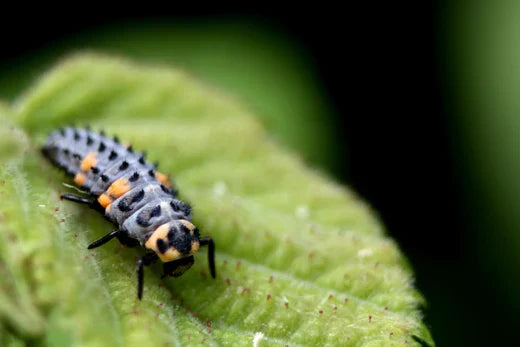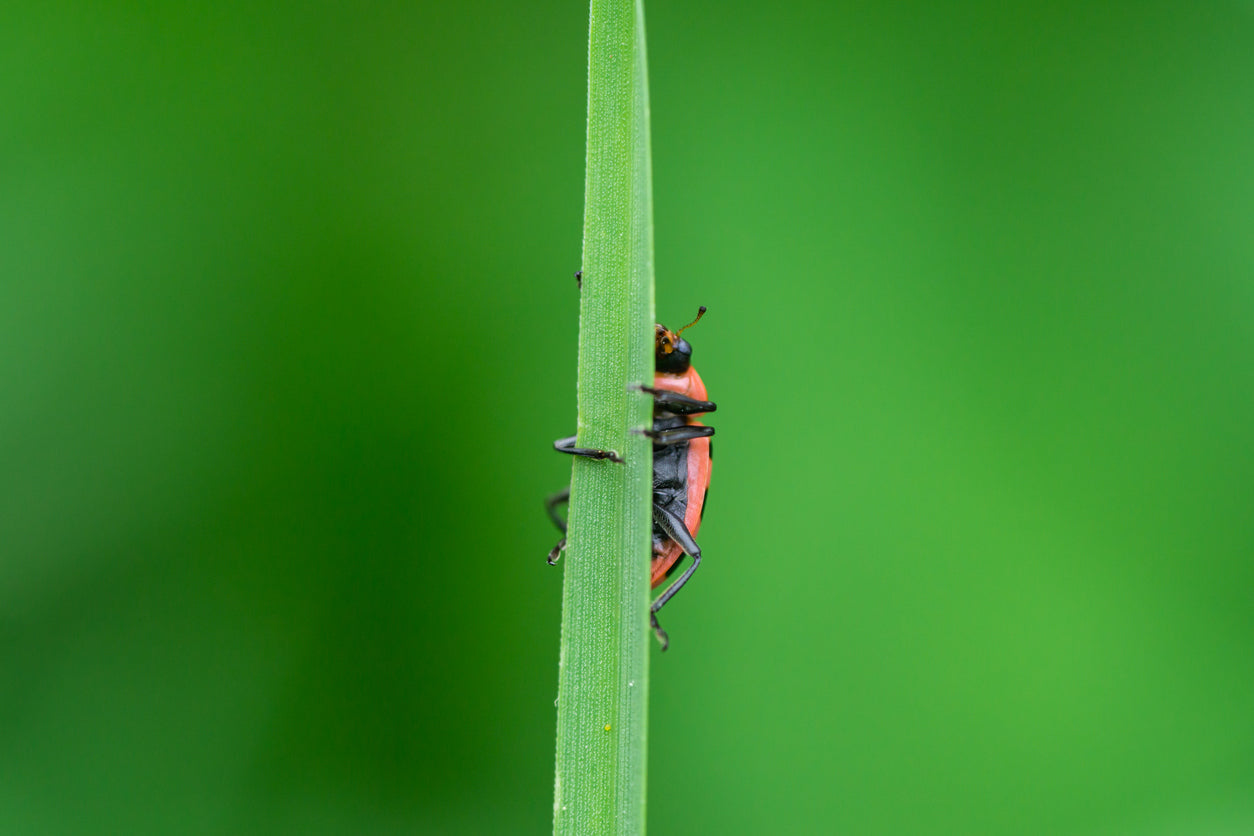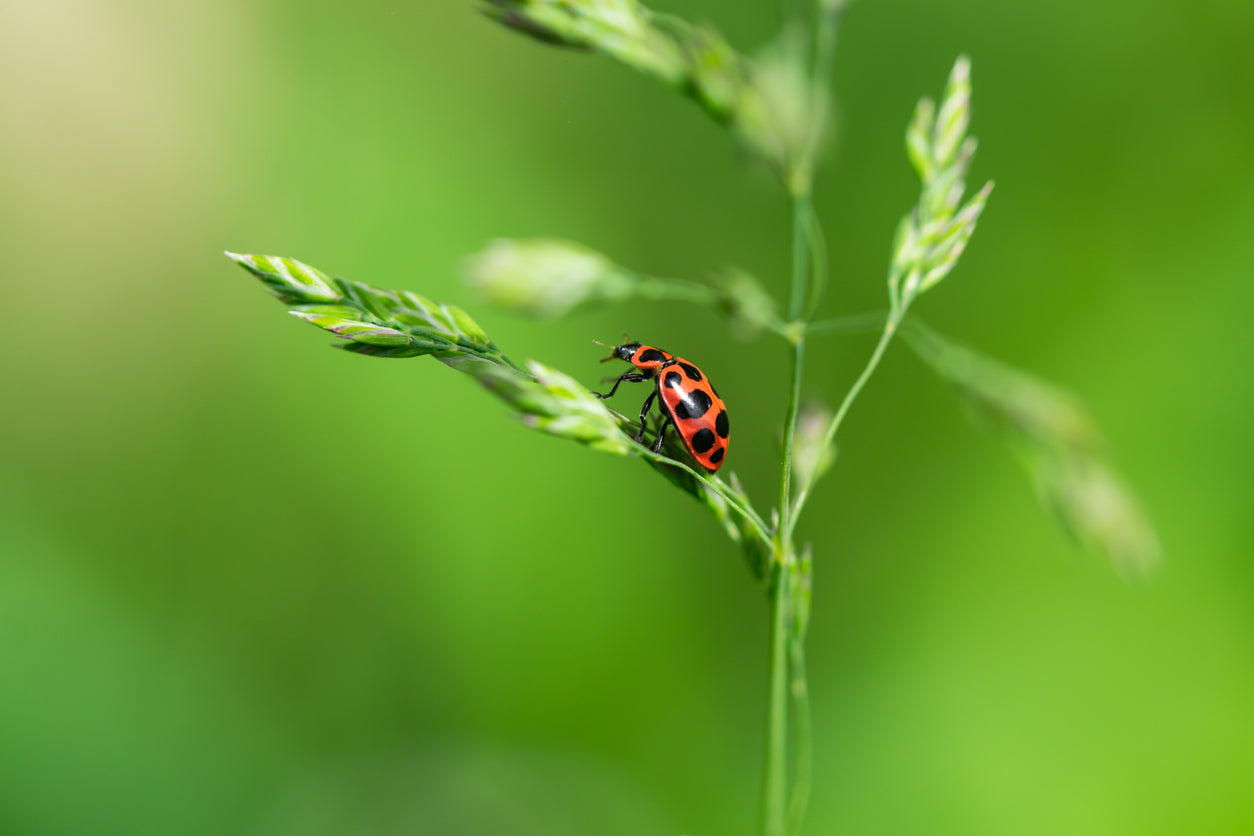Add description, images, menus and links to your mega menu
A column with no settings can be used as a spacer
Link to your collections, sales and even external links
Add up to five columns
Add description, images, menus and links to your mega menu
A column with no settings can be used as a spacer
Link to your collections, sales and even external links
Add up to five columns

Life Cycle of a Ladybug
By Spencer McManamna March 25, 2024 9 min read
With their vibrant colors and charming demeanor, ladybugs are among the most beloved insects in the natural world. Beyond their endearing appearance lies a remarkable life cycle that showcases nature's ingenuity and resilience. Join us as we unravel ladybug facts like the mysteries of the ladybug life cycle, shedding light on the stages of growth, transformation, and adaptation that define our beloved beetles!
Ladybug Mating
Like most insects, ladybugs engage in sexual reproduction. Sexual reproduction in ladybugs involves the fusion of sperm and egg to produce offspring.
Sexual Reproduction in Ladybugs:
-
Mate Attraction: Ladybugs typically use chemical cues to find potential mates. Once a suitable mate is found, they engage in courtship behaviors, which can involve physical interactions and pheromone signaling.
-
Copulation: Male ladybugs use their genitalia to transfer sperm into the female's reproductive tract during copulation. The mating process can vary in duration depending on species.
-
Fertilization: Inside the female's body, the sperm fertilizes the eggs. Fertilization usually occurs shortly after mating.
-
Egg Laying: After fertilization, the female lays clusters of eggs on plants, often near a food source for the emerging larvae.
-
Development: The eggs hatch into larvae, which go through several instars before pupating. The pupa eventually develops into an adult ladybug.
Comparison with Asexual Reproduction:
Unlike sexual reproduction, asexual reproduction does not involve the fusion of gametes (sperm and egg) and only requires one parent.
Genetic Variation
- Sexual reproduction introduces genetic variation as offspring inherit genetic material from both parents. This genetic diversity can be beneficial for adaptation to changing environments.
- Asexual reproduction produces offspring that are genetically identical to the parent, lacking genetic variation. This can be an advantage in stable environments but may hinder adaptation to new conditions.
Energy Investment
- Sexual reproduction typically requires more energy and resources as it involves finding and attracting mates, courtship rituals, and producing gametes.
- Asexual reproduction often requires less energy and resources since it only involves the individual organism reproducing itself without the need for finding a mate or producing gametes.
Speed of Reproduction
- Asexual reproduction is often faster than sexual reproduction since it doesn't involve the time-consuming process of finding and courting a mate.
- Sexual reproduction may take longer due to mate attraction, courtship, and the development of offspring from fertilized eggs.
Adaptability
- Sexual reproduction allows for greater adaptability to changing environments due to genetic variation and recombination.
- Asexual reproduction may result in populations that are less adaptable to environmental changes since there is no genetic mixing to generate diversity.
Ladybugs reproduce sexually through the fusion of sperm and egg, leading to genetic variation among offspring. This process contrasts with asexual reproduction seen in some other insects and animals, which involves producing genetically identical offspring from a single parent.
Impact of Temperature on Ladybug Mating
In temperate regions, ladybugs typically mate during the spring and early summer months when temperatures rise and food sources become more abundant. This period allows for optimal conditions for mating and offspring development.
In tropical regions where temperatures are relatively stable throughout the year, ladybugs may not have a distinct mating season. Instead, they may mate opportunistically whenever conditions are favorable, such as during periods of increased food availability or warmer environmental conditions.
Ladybug Mating Frequency
Ladybugs can mate multiple times during a mating season or throughout the year, depending on factors such as availability of mates, food resources, and environmental conditions. The frequency of mating can vary among species and populations.
Female ladybugs produce pheromones to attract males. These chemical signals are released into the environment and serve as cues for males to locate potential mates. Males detect these pheromones using specialized sensory organs, such as antennae, and follow the scent to find the female.
How Ladybugs Select Mates
Female ladybugs may select mates based on factors such as size and color, which can indicate the health and fitness of the male. Larger males may be preferred by females as they may be able to provide more resources or have a higher reproductive success. Brightly colored males may also be preferred as they may signal genetic quality or indicate the ability to defend territory or compete for resources.
During copulation, the male transfers sperm to the female's reproductive tract, ensuring fertilization of the eggs. The extended duration of copulation may allow for increased sperm transfer and higher chances of successful fertilization.
In summary, ladybugs mate during specific seasons in temperate regions, while in tropical regions, mating may occur opportunistically throughout the year. Female ladybugs use pheromones to attract males and may select mates based on size and color. Copulation can last for extended periods, facilitating successful fertilization and reproduction.
Stage One: Ladybug Eggs

Appearance of Ladybug Eggs
- Ladybug eggs are typically small, elongated, and oval-shaped, measuring about 1 to 2 millimeters in length.
- They are often yellow to orange in color, although some species may lay eggs that are white or pale in color.
- Ladybug eggs are usually laid in clusters, which can vary in size depending on the species but typically contain around 10 to 50 eggs.
Internal Holding of Eggs
- Female ladybugs have the ability to hold their eggs internally for several weeks to months after fertilization. This process is known as delayed oviposition.
- Delayed oviposition allows female ladybugs to regulate the timing of egg laying based on environmental conditions such as temperature, food availability, and the presence of suitable oviposition sites.
- This ability provides flexibility in reproductive timing, ensuring that eggs are laid under the best conditions for their offspring's survival.
Deposition of Eggs
- Female ladybugs deposit their eggs in rows or clusters along the undersides of leaves or beneath plant stems, where they are out of sight!
- Ladybugs prefer to lay their eggs in sheltered locations that offer protection from predators and environmental stressors.
- Different species of ladybugs may preferentially lay their eggs on specific plant species or in particular ladybug habitats.
Nearness to Food Source
- Ladybugs typically lay their eggs near a food source, often targeting areas with high populations of aphids, which are a primary food source that attracts ladybugs and their larvae.
- By laying their eggs near aphid colonies, female ladybugs ensure that their offspring will have immediate access to food upon hatching.
- This increases the chances of survival and growth of ladybug larvae, which rely on aphids for nourishment during their development.
Number of Eggs Laid
- One female ladybug can lay anywhere from a few dozen to several hundred eggs over her lifetime!
- The number of eggs laid at one time can vary but is typically in the range of 10 to 50 eggs per cluster.
Incubation Period
- Ladybug eggs typically hatch within 3 to 10 days after being laid, although the exact incubation period can vary depending on species and environmental conditions.
- Once hatched, the newly emerged ladybug larvae begin to feed on nearby prey, such as aphids, to fuel their growth and development into adulthood.
In summary, ladybug eggs are small, elongated, and typically laid in clusters on the undersides of leaves near aphid populations. Female ladybugs have the ability to hold their eggs internally for extended periods before laying them, ensuring the best possible conditions for offspring survival.
Stage Two: Ladybug Larvae


A larva is the immature stage of an insect's life cycle, undergoing transformation and development before reaching adulthood. The larval stage follows hatching from the egg and precedes the pupal stage.
Larvae Appearance
During the larval stage, ladybugs exhibit a distinct appearance very similar to a tiny, black alligator with black spots or stripes. Ladybug larvae typically have elongated bodies with six legs, segmented abdomens, and distinctive markings. They may also possess spines or bristles for defense against predators.
Larvae Duration
Ladybugs spend different amounts of time in the larval stage, depending on factors such as species, environmental conditions, and food availability. Generally, the larval stage lasts for about 2 to 4 weeks!
Larvae Predation
Ladybug larvae are voracious predators, primarily feeding on soft-bodied insects such as aphids, scale insects, and mites. A single ladybug larva can consume a large number of prey during its larval stage, often exceeding its own body weight in food each day. This high consumption rate contributes to the rapid growth and development of ladybug larvae.
Molting
During the larval stage, ladybug larvae undergo several molts as they grow and increase in size. Molting is the process of shedding the old exoskeleton (cuticle) to allow for growth and development. Ladybug larvae typically molt several times before entering the pupal stage.
The molting process involves the following phases:
-
Preparation: Before molting, the larva secretes enzymes to soften the old cuticle and create a space between the old and new cuticles.
-
Shedding: The larva splits its old cuticle and emerges from it, revealing a soft, new exoskeleton underneath.
-
Expansion: After shedding the old cuticle, the larva rapidly absorbs water to expand its body and stretch the new exoskeleton to its full size.
-
Hardening: The new exoskeleton gradually hardens and darkens, providing protection for the growing larva until the next molt.
These molting phases allow ladybug larvae to accommodate their increasing size and developmental changes as they progress toward the pupal stage and finally adulthood!
Stage Three: Ladybug Pupa
A pupa is the transitional stage in the life cycle of insects during which the larva undergoes metamorphosis into its adult form. In this stage, the insect undergoes significant internal and external changes as it transforms from the larval form to the adult form.
During the pupal stage, ladybugs exhibit a distinct physical structure characterized by an orange segmented shell with black spots. The pupa is typically immobile and encased within a protective outer covering, often referred to as a pupal case or cocoon. Inside this shell, the transformation from larva to adult occurs, with the developing adult structures becoming increasingly visible over time.
Histoblasts
Histoblasts are cells in the developing insect embryo that become specific tissues and organs during metamorphosis. In ladybugs, histoblasts play an important role in the transformation process from larva to adult. These cells transform into various adult structures, such as wings, legs, antennae, and reproductive organs, allowing the insect to complete metamorphosis.
Pupae Activity
During the pupal stage, ladybugs do not move or eat! Instead, they rely on the nutrients stored within their bodies from the larval stage to fuel the transformation process. The pupa remains largely inactive within its protective shell, undergoing internal changes as it develops into an adult.
Pupal Stage Duration
The duration of the pupal stage varies among ladybug species and can also be influenced by environmental factors such as temperature and humidity. Generally, ladybugs spend approximately 5 to 7 days in the pupal stage before emerging as fully developed adults. However, this timeframe can vary depending on species-specific characteristics and environmental conditions.
The pupal stage is a critical period in the life cycle of ladybugs during which larval structures are transformed into those of the adult insect. Histoblasts play a vital role in this transformation, providing the cellular basis for the development of adult structures. Ladybugs rely on stored nutrients from the larval stage to sustain them during the pupal stage, during which they remain immobile and undergo internal changes within their protective pupal case.
Stage Four: Adult Ladybug
 At the final stage of development, adult ladybugs typically exhibit a pale green coloration with a soft exoskeleton that gradually hardens and changes color over time. Upon emerging from the pupal stage, adult ladybugs may appear somewhat delicate and vulnerable. However, as their exoskeleton hardens, they acquire the famous bright red or orange coloration with black spots and markings that are most commonly associated with our ladybug friends.
At the final stage of development, adult ladybugs typically exhibit a pale green coloration with a soft exoskeleton that gradually hardens and changes color over time. Upon emerging from the pupal stage, adult ladybugs may appear somewhat delicate and vulnerable. However, as their exoskeleton hardens, they acquire the famous bright red or orange coloration with black spots and markings that are most commonly associated with our ladybug friends.
Wings
Adult ladybugs have complex wing structures that fold neatly beneath their hardened elytra (wing covers), allowing them to fly whenever necessary. They also possess six jointed legs and prominent antennae for effective sensory perception.
Exoskeleton
The process of hardening the ladybug's exoskeleton and the development of functional wings occurs gradually after emerging from the pupal stage. The exact duration varies depending on factors such as environmental conditions and individual species. Generally, it takes several hours to a day for the ladybug's shell to fully harden, providing protection and structural integrity. Similarly, it may take up to a few hours or a day for the wings to expand and become fully functional for sustained flight.
Sexual Maturity
After completing their development into adult ladybugs, individuals typically require some time to reach sexual maturity and become capable of mating and reproducing. This maturation period can range from a few days to a couple of weeks, depending on species-specific characteristics and environmental factors.
Lifespan and Reproduction
The lifespan of an adult ladybug varies among species but usually ranges from a few weeks to several months. During this time, adult ladybugs may reproduce multiple times, with females laying clusters of eggs on suitable substrates such as plant leaves or stems. The frequency of reproduction depends on many different factors such as environmental conditions, availability of food, and suitable oviposition sites.
Some species may reproduce more frequently under favorable conditions, while others may have more limited reproductive cycles. Ladybugs are relatively short-lived insects but can produce multiple generations within a single season. This makes them the perfect garden protectors, effective as natural pest control agents in both agricultural and garden ecosystems.
Also in Ladybugs

All About Ladybugs, Climate and Temperature
October 10, 2024 4 min read
Nature lovers have often wondered how our little ladybug friends manage to survive a season that can often be quite harsh for insects. Read on to discover how ladybugs survive and thrive in both high and low temperatures, and what the future holds for them with the approach of climate change.

What Do Ladybugs Eat?
August 15, 2024 5 min read
Have you ever wondered what our ladybug friends like to munch on? It's a surprisingly varied diet! Read on to learn more about the incredible things our little ladybug friends like to snack on!

Enter Your Voucher Code Below
If you are experiencing difficulty redeeming your voucher on your desktop, please use a mobile device for a better redeeming experience.

We are unable to combine redemption fees. If you are redeeming 1-5 voucher codes, please complete separate purchases through our website for each voucher. If you are redeeming 6+ vouchers, please email us at customerservice@insectlore.com with your voucher codes and shipping address and we'll send you a custom invoice for payment.
Thank you for Redeeming your voucher!
You redeemed a $title

Don't miss this special one Time Offer.
Check the Box to Add this Special Offer to your Cart

Don't miss this special one Time Offer.
Check the Box to Add this Special Offer to your Cart
It looks like you are an Insect Lore UK/EU customer! You are visiting the Insect Lore USA website.
Click Insect Lore UK/EU website to be redirected to insectlore.co.uk.




